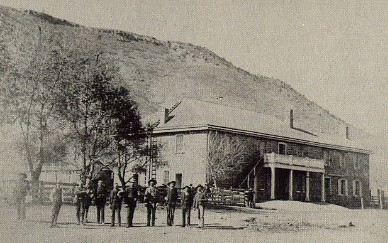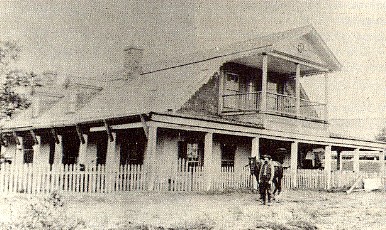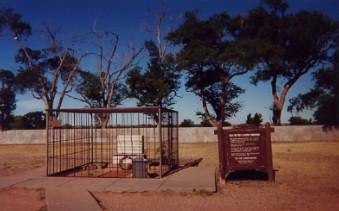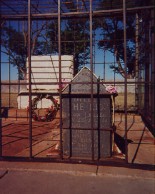|
The day after being sentenced the Kid was loaded into a coach for the
five-day journey to Lincoln, and again was told if there were a rescue
attempt or a lynch mob, his guards would kill him first. There were seven
heavily armed men in the escort, including Bill Mathews, John “King of the
Rustlers” Kinney, and the burly Bob Olinger. All three
fought on the Dolan side and were prejudiced against the Kid -Olinger in
particular. The Kid and Olinger had a mutual hatred because Olinger shot
John Jones, a friend of the Kid’s, in cold-blood. Afterwards, Olinger
learned the Kid wanted to kill him in revenge. Their resentment for each
other sparked the bitter
animosity. During the long trip to Lincoln, Olinger took advantage of the
Kid’s helpless situation by taunting and provoking him to escape. The Kid
kept his sense of humor and ignored him. It was a tense trip. If the Kid so
much as made a wrong move, his guards would have shot him, but sources say
he remained in good spirits.
|

James Dolan (seated) & Bob Olinger (1879)
Photo from R.G. McCubbin Collection |
Finally on April 21st, the Kid arrived in
Lincoln. There was no suitable jail, so the Kid was confined in a backroom
adjoined to Garrett’s office in the old two-story Murphy store, which was
now a courthouse. He was to remain handcuffed and shackled at all times and
was either chained to the floor or a line was drawn across the room, which
he was forbidden to cross or he would be shot. To eliminate any chance of escape,
Garrett had two of his deputies remain with the Kid in the room as a 24-hour
gurad; the two guards were Olinger and James Bell.
|
|

The Courthouse in Lincoln (late 1880s-90s)
Photo from R.N. Mullin Collection
The staircase from the balcony was not added until much later after the
Kid's escape.
Billy the Kid was confined on the second story, front left corner room.
The side window you see is where the Kid shot Olinger. |
|

Lincoln courthouse as it looks today.
Webmaster's photo (2000)
Not much as changed, other than the roof and another staircase added to the balcony.
The once hard to see scrawny tree, as seen in the first photo, has now grown so large it blocks out
the view
of Billy the Kid's room. |
Any other prisoner would have given up hope and come to grips with his fate,
but not the Kid! His mind was still at work on escaping, but time was
running out. The Kid had to act fast on the first opportunity, but he had to
wait patiently for the right moment. If he made the slightest wrong move or
even looked as if he was thinking of escape, Olinger would split him in two with his shotgun, which he
teased the Kid with everyday.
About a week after the Kid's arrival, Garrett had left Lincoln to collect
taxes, leaving his two guards in charge. On April 28th, at noon, with only two
lawmen in the whole town, the Kid saw his golden opportunity. He knew it was Olinger’s turn to take the other prisoners, who were also confined at the
courthouse, across the street for lunch at the Wortley Hotel (the Kid ate
his meals in his room), which meant only Bell would be at the courthouse to
guard him. The Kid knew, out of his two guards, it would be best to make his
move on Bell who was easy-going and not on a power trip as Olinger was. As
soon as Olinger was long gone with the other prisoners and eating his meal,
the Kid then made his move. The only time the Kid was allowed to leave the
room was for visits to the privy (outhouse), so he asked Bell to take him outside.
What happened next is a subject for debate; one version, which seems the
more popular, is that the Kid retrieved a gun that was hidden in the privy
by a friend. As he entered the courthouse and climbed the stairs and
reached the top, he turned around with the gun drawn and told Bell to
surrender. Bell panicked and spun around to run down the stairs leaving the
Kid with no choice but to shoot him.
The
next version, which I find the most logical, comes from the Kid himself.
After his escape, the Kid told his friend, John Meadows, whom he visited
right after he left town a free man, that he slipped his small hand out of
one of the cuffs, whacked Bell over the head and jerked Bell’s revolver out
of the holster and told him to throw up his hands. But instead, Bell turned
and ran down the stairs and the Kid shot him. This then explains the two
gashes found on Bell’s head, the scuffling sound which was heard from the
groundskeeper, Gottfried Gauss, who was standing outside by the door and
caught the dying Bell as he rushed into his arms, and lastly, it explains
why Bell just ran instead of pulling out his own gun and shooting as he
fled. After all, Bell was a veteran lawman, and couldn’t have been that
timid (or stupid).
At the restaurant, Olinger heard the shots fired and darted outside. As he
rounded the gate into the yard of the courthouse, he heard a familiar voice,
“Hello Bob.” he looked up and saw the Kid at the window with his own shotgun
pointing right at him. At that moment the startled groundskeeper came
running from behind the building, saw Olinger and yelled out, “The Kid
killed Bell!” Olinger then replied, “Yes, and he’s killed me too.” The Kid
then let Olinger have it with both barrels and his tormentor and killer of
his friend John Jones, fell dead.
Next, the Kid had Gauss toss him up a small pick that was lying on the ground
and told him to saddle a horse. The townspeople made no move to interfere as
the Kid took his sweet time in leaving. After using the pick to free only
one leg from the shackles, the Kid went out on the balcony and saw that a
small crowd had gathered and was watching from from across the street; a
witness’s statement of what the Kid said would verify how he killed Bell:
“He stood on the upper porch in front of the building and talked with the
people who were in Wortley’s, but he would not let anyone come towards him.
He told the people that he did not want to kill Bell, but as he ran, he had
to. He said he grabbed Bell’s revolver and told him to hold up his hands and
surrender and that Bell decided to run and he had to kill him. He declared he
was ‘standing pat’ against the world and while he did not wish to kill
anybody, if anybody interfered with his attempt to escape, he would kill
him.”
After arming himself with revolvers and a rifle, he went down the stairs and
out the back door. As he passed the body of Bell, Gauss heard him say, “I’m
sorry I had to kill you, but couldn’t help it.” As the Kid went around the
building to the gate, with Gauss probably following behind leading a saddled
horse, the Kid came to the blood-soaked body of Olinger. Showing no remorse
as he had shown for Bell, he kicked the corpse and said “You’re not going
to round me up again!” The Kid mounted the horse with some difficulty on
account of his leg irons that were dangling from one leg and rode off. The
townsmen made no move to stop him, though they could have easily mobbed or
shot him to death, but instead they stood back and allowed him to escape. It
wasn't because they were “paralyzed with fear” as Garrett claimed, but more
likely, it was out of sympathy and understanding of Billy the Kid's
predicament.
|
*********************************** |
Instead of making a run for the border,
the Kid hung around in the county, dropping by on friends and telling them
about his daring escape from jail as if he had just come back from
vacation. His friends advised him to leave the territory, but the Kid was
confident he wouldn’t get caught and he told them he would first go to Fort
Sumner to get some money.
For the next two months the Kid hid out
at different locations in San Miguel County, but mostly in Fort Sumner.
There was a number of Billy the Kid sightings, but how many of them were
legitimate is up for debate. One thing was for certain, the Kid had returned
to his old haunts and was making no immediate plans of leaving New Mexico.
Meanwhile, Sheriff Garrett was doing a low
profile search for the Kid. Unlike before, he wouldn’t form a large posse,
nor would he even try to catch him alive. His plan was to sneak up on the Kid and
kill him. By early July, Garrett received word that the Kid was in or near
Fort Sumner and he may have gotten this tip from Pete Maxwell, the older
brother of Paulita Maxwell, one the Kid’s girlfriends. Maxwell didn’t like
the Kid around his sister, who was going to marry a prominent and wealthy
figure in New Mexico. So with information on the Kid’s whereabouts, Garrett
took John Poe and Kip McKinney with him; men he could trust to keep their
mouths shut and not question his actions, and he headed to Fort Sumner quietly.
It was July 14, 1881. The Kid was warned that the law was looking for him in
the area, so he hid out at a sheepherder’s camp. But by the afternoon or
evening, he decided to ride into Fort Sumner. Garrett had searched the area
and even sent Poe in town to
look around; becoming frustrated, Garrett was thinking about leaving (or he knew the Kid
was at the Fort and was just waiting for the right moment). The Kid, in
the meantime, was hiding in town unaware that Garrett was in the vicinity;
he visited with his friends and sweethearts, going from one house to the
other, but where exactly and with who he planned to stay with for the night is questionable.
|

Pete
Maxwell's house (1882)
Photo from R.G. McCubbin Collection
Billy the Kid was shot and killed in Pete Maxwell's bedroom.
It's a bedroom that is entered from the side of the house (not in),
the first left corner room just beyond the gate and behind the
pillar.
|
It was getting late and the residents were
bedding down for the night, Garrett slipped out of the shadows and went to
Pete Maxwell’s house to ask him about the Kid. While Poe and McKinney waited
outside, Garrett entered Maxwell’s room and woke the sleeping man. At that
moment, the Kid, who was staying at a friend’s house, was getting hungry.
His host or hostess told him that Maxwell had butchered a yearling and for
him to help himself to it, and then bring the meat back and they would cook
it
for him. The Kid grabbed a butcher knife and stepped outside and walked
across the plaza to Maxwell's house. As he approached the porch, he
almost stepped over the two men who were sitting down outside Maxwell’s
room. The men rose and told the intruder not to be startled. The Kid didn’t
recognize the men and backed into Maxwell’s dark bedroom. Once inside he walked
over to the bed and in a low voice he said “Pete…Who are those fellows
outside?” Garrett was sitting at the foot of the bed and Maxwell lay still and
whispered, “That’s him.” The Kid walked closer to the bed and again asked
“Pete?” then he saw the silhouette of a figure sitting in front of him. The
Kid moved back slowly, and said “Quien es?” Garrett recalled in The
Authentic Life of Billy the Kid, “He must have recognized me, for
he went backwards in a cat-like movement, and I jerked my gun and fired.”
Garrett fired twice, the Kid fell to the floor, and then both Garrett and
Maxwell bolted out the door. The Kid was shot through the heart and gasped
for a minute or two and died. The men outside huddled outside the door and
heard the Kid’s death rattle. Certain the Kid was dead, Maxwell got a candle and the men
entered the room. They found the Kid lying on his back in the middle of the
room with a gun in one hand and a knife in the other.
This is the story that Garrett told and has been accepted, but did it really
happen this way? Was the Kid really armed or had his gun drawn? Since he
didn’t die right away, how come he didn’t shoot back or if the gun was in
his hand, surely the reaction of getting hit in the chest by a bullet would have caused the gun to go
off, but yet Garrett stated the Kid did not fire. Was it really coincidental
that the Kid walked in on Garrett and surprised him or was Garrett waiting for him? According
to McKinney, Garrett tied up and gagged one of the Kid’s girlfriends and hid
in the room and waited for him to walk in. I don’t know about you, but
something smells fishy. Considering Garrett’s earlier methods of dealing
with outlaws, which was by ambush, this incident probably wasn’t as “Kosher”
-if you will- as Garrett would want us to believe.
The residents were awakened by the gunfire
and walked out into the plaza towards Maxwell’s house. Upon learning that
the Kid was dead, men were shaking their fists at Garrett and women were
weeping. Garrett allowed the Kid’s friends to take his body across the plaza
to the carpenter’s shop to give him a wake. The next morning, Justice
of the Peace, Milnor Rudulph, viewed the body and made out the death
certificate, but Garrett rejected the first one and demanded another one be
written more in his favor. The Kid’s body was then prepared for burial, and
at noon he was laid to rest next to his two friends: Tom O’Folliard and
Charlie Bowdre.
New Mexico’s famous outlaw Billy the Kid, about nineteen or twenty years
old, was dead, but his legend was
born.
|
 |
 |
|
The gravesite of Billy the Kid in Fort Sumner
Webmaster's photo (2000)
The epitaph on the smaller gray stone reads:
BILLY THE KID
Born Nov 23 1860 Killed Jul 14, 1881
THE BOY BANDIT KING
HE DIED AS HE HAD LIVED
|
|
*********************************** |
After the Kid’s death, Garrett was viewed
with suspicion, though there were many who were grateful for Garrett riding
the territory of the famous outlaw, just as many felt it was foul play. To
win public opinion, Garrett, with the help of Ash Upson, wrote a biography
on Billy the Kid, and if one reads it closely, you can sense Garrett’s
remorse. Maybe he hoped writing the book would lift the dark cloud that hung over
him, which may be why Garrett portrayed the Kid as half Satan to make him a threat to society to gain reader’s support for his actions, and then
half Saint, to show his admiration for the Kid and how he was only doing
his duty in hunting the young outlaw. In the end, the book made a Judas
out of Garrett for going after his old friend and killing him. The biography
ended up turning Billy the Kid into a legend and Pat Garrett as the
villain. For the rest of his life, Garrett was haunted by a guilt
conscious, he would become uncomfortable when people asked him about the
killing, and he would later hint to friends that he wished he never took
the job to hunt down the Kid. This regretful behavior by Garrett
furthers my assumption that he planned out and ambushed the Kid in the
dark with Pete Maxwell's help.
History has been very unfair to Billy the
Kid. I don’t think any other western historical figure has had his name
dragged through the mud and represented so inaccurately and negatively. He
never robbed banks or trains like Jesse James. He never killed without a
probable cause like men such as John Wesley Hardin and Clay Allison. He
never was a large-scale rustler, raiding ranches and terrorizing the
inhabitants like John Selman or Jesse Evans. He never hurt, raped or
insulted women, nor harm children or the elderly.
But I’ll tell you who Billy the Kid was:
he was an orphan who unintentionally fell into outlawry, a lifestyle he
couldn’t get out of. He tried to make peace with the law and his enemies,
and both times it backfired on him, making things worse. He was never the
captain of the Regulators, but just another fighter. The Lincoln County War
itself would have turned out the same way, if he had never taken part in it.
He killed only in self-defense and during the war. The men he killed weren’t
angels, but were either bullies or outlaws, like the case of Morton and
Baker, who were both members of “the Boys.” The lawmen he killed were not honest
men trying to “protect and serve,” but crooked and corrupt. The Kid did
steal livestock, but in some cases he either paid for or returned what
he had taken. He even recovered stolen livestock for small ranchers and
judging by the poverty state he was always in, it seems he didn't steal enough.
I’m not saying Billy the Kid was an angel who
rode around with a halo over his head. He did do some wrong, but he was not
a Charles Manson of the 19th century. There were other outlaws
of his time who fit that bill, and that’s why no one today has really heard
of them, because they really were bad and not worth remembering.
In closing, I hope I have changed
someone’s perspective on Billy the Kid, from a dark villainous outlaw to a
misunderstood youth, an underdog, a rebel, a scapegoat and a good badman.
If you have read this whole
biography from beginning to end, I congratulate and thank you for your
time and patience, and most of all your interest to learn more about Billy
the Kid. Thank you for visiting my website and I hope you found it
informative.
BIBLIOGRAPHY
Bell, Boze Bob The Illustrated Life and Times of
Billy the Kid Second Edition,
Tri-Star-Boze Production, Inc. 1996
Nolan, Frederick The West of Billy the Kid
University of Oklahoma Press,
Norman 1998
Nolan, Frederick Pat Garrett’s The Authentic Life
of Billy the Kid, An
annotated edition with notes and commentary by
Frederick Nolan, University of Oklahoma Press, Norman 2000
Tatum, Stephen Inventing Billy the Kid:
Visions of the Outlaw in America, 1881-
1981 University of New Mexico Press, Albuquerque 1982
|
